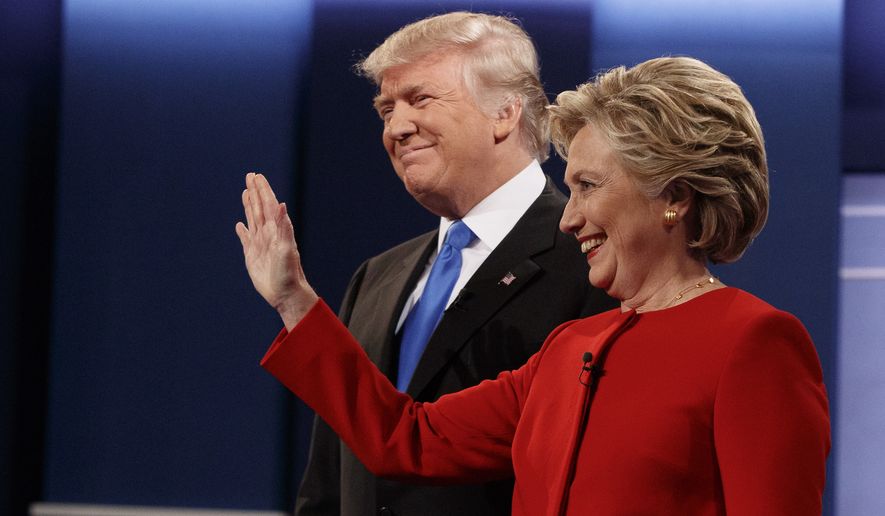OPINION:
Let’s rewind back to October 2016. Hillary Clinton held a 12-point lead over then-candidate Donald Trump, according to traditional polling. Weeks from Election Day, she had cracked 50% support nationally in the polls, while Mr. Trump dwindled in the 30s.
No one in the political establishment expected Mr. Trump to put up much of a fight. Pundits were generally convinced he stood no chance, and the liberal media was ready to crown Mrs. Clinton.
Then Election Day came, and Hillary lost. The polls and the pundits were proved wrong — again.
That the polls were dead wrong and Mrs. Clinton lost isn’t as important, however, as why she lost. Within her own party, Mrs. Clinton could rely on plenty of rank-and-file zealots who were excited to elect the first female president. But she wasn’t popular or likable beyond them.
Mrs. Clinton was so unpopular — even among Democrats — that a self-proclaimed democratic socialist from Vermont posed a credible challenge, and she was beset upon by lackluster support from within while relying too heavily on mercenary consultants. On the other side, voting against Hillary was an article of faith for Republicans. Mrs. Clinton lost because the middle — the swing voters who ultimately decide elections — just didn’t like her.
Fast forward to January 2024, and if the polls are to be believed (they shouldn’t be), Mr. Trump maintains a 30-point lead in the Republican primary cycle. Legacy polling sees Florida Gov. Ron DeSantis and former U.N. Ambassador Nikki Haley as little more than long shots. And Mr. Trump is neck and neck with President Biden in key battleground states — again, according to traditional polls.
But should Republicans keep taking the polls at face value? Should we trust the polling that has Mr. Trump beating Mr. Biden in states like Michigan? Absolutely not.
If traditional polls have taught us anything in recent years, it is not to trust them — or the paid consultants and fundraisers promoting polls, and the legacy media parroting them. The polls have been dead wrong since 2016, leading to Republican losses in 2018, 2020, 2022 and even 2023.
Traditional polling’s failures start with the wrong, limited and arbitrarily defined data sets to decide whom to call, and it goes further off the rails by generally reaching and getting responses only from the most ardent political zealots — those desperate to convince you (and themselves) their outsider views are right.
No amount of “weighting” applied by pollsters to “fix” their oversampling of extremes will work. It just makes the results more unreliable. Even polling averages don’t help, since the average of all that junk is still junk.
The more accurate measure of U.S. public opinion is “anti-polling,” which monitors actual behavior of massively large populations over time — what they say and what they do when they’re not aware of being monitored. Anti-polling uses observational analysis to strip away the biases and errors that make traditional polling unreliable.
After nearly two years of monitoring real data on the Trump, Biden and DeSantis dynamic, there is one constant: Mr. Trump can’t win swing voters.
Mr. Trump is so unpopular — even within his own party — that his Napoleonic return is blunted by a serious challenger, and he is beset upon by lackluster support from within while relying too heavily on mercenary consultants. On the other side, voting against Mr. Trump remains an article of faith for Democrats. Above all, swing voters generally don’t like Mr. Biden, but they loathe Mr. Trump.
Sound familiar?
Mr. Trump has experienced a constant series of “post-indictment” bumps among swing voters aggravated by the weaponization of government. They believe, rightly so, that he is being treated unfairly by the establishment. But the bumps always fade fast, and they are not enough to carry him through a general election.
Most swing voters oppose the Democrats’ legal chicanery and are generally negative on “Bidenomics” and this failing presidency. But that sentiment pales in intensity with their distaste for Mr. Trump. Opposing Biden Democrats is one thing; casting a vote for Donald Trump, however, is untenable.
Like Mrs. Clinton’s own loyalists, Trump voters don’t represent a large enough voting bloc to cross the finish line. Third-party data from Eyesover confirms that, while there are almost always more social media posts about Mr. Trump, his supporters are more likely to post, and post more frequently.
Case in point: Since October, those making positive online posts about Mr. Trump have grown by 6%, while the volume of those posts has grown by 7%.
A separate eight-month study of nearly 20 million home IP addresses makes the “Trump prison” all too clear — 17% to 22% of the electorate that doesn’t grow, but from which his now-former supporters slowly get paroled.
So ask yourselves, Republicans: Do we want Mr. Trump to be our Hillary? Do we want to enter Election Day with the same supreme confidence, only to lose for the fifth time in a row?
I’m sick of losing. It is time to start winning again, and this is coming from a two-time Trump voter.
Heading into the Iowa caucus, Donald Trump may appear to be the strongest Republican in the field, but that means nothing come November. By then, we could be looking at the next Hillary Clinton.
• Dan Backer is a veteran campaign counsel, having served more than 100 candidates and political action committees, including the pro-DeSantis Ready to Win. He practices law as a member of Chalmers, Adams, Backer & Kaufman LLC.




Please read our comment policy before commenting.